Note: This is the first in a series of articles featuring Managed Forest Law landowners. This feature of Jim Schiller was written by Art Kabelowsky, a communications specialist in the Division of Forestry. Kabelowsky took the photos as well.

Forest landowner Jim Schiller teams up with DNR’s Managed Forest Law program on his successful woodland property near New Glarus.
Not even a chilly, overcast Monday afternoon could dampen the enthusiasm of Jim Schiller as he showed off his favorite place.
While taking a visitor on a tour of his 29-acre woodlot west of New Glarus in Green County, Schiller paused frequently to explain the past, present and future of each section of the property.
A few red oak trees here, some walnut trees there, a group of white oak trees planned on the other side of the path … spots where he’ll plant conifer seedlings to help protect his deciduous trees … areas where he has begun work to control invasive species such garlic mustard … his thoughts on when and what to harvest.
“You’ve always got to be thinking ahead,” Schiller said. “That’s the main thing I’ve gotten out of all of this.”
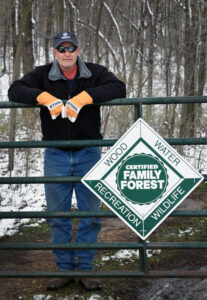
Jim Schiller at the entrance gate of his 29-acre woodlot west of New Glarus, which he manages under the guidelines of the Managed Forest Law program.
Schiller knows the past and present of his woodlot so well, he can point out individual trees and predict their future — from “that one’s going to be OK” to “I don’t think this one will make it.”
Schiller bought an 11-acre plot in 1992 and enrolled in the Managed Forest Law (MFL) program soon after taking his first cutting in 1992 and 1993.
“We took out 33,000 board feet. We did a clearcut on two acres and planted 500 red oak and 500 walnut,” he said. “The value of the land went up and we recouped all of the original cost,” Schiller said.
After the harvest, the process of cleaning up treetops was done manually. They were placed in piles and then burned in the clearcut area. “Everything was done manually back then,” Schiller said.
In 2017, Jim Schiller was able to add an additional 18 acres.
Schiller, 66, spends a lot of time and thought managing his woodlot. The job takes equal parts brain power and elbow grease. Schiller gets help from the DNR on the former and from a large group of family and friends (and, every once in a while, paid professionals) on the latter.
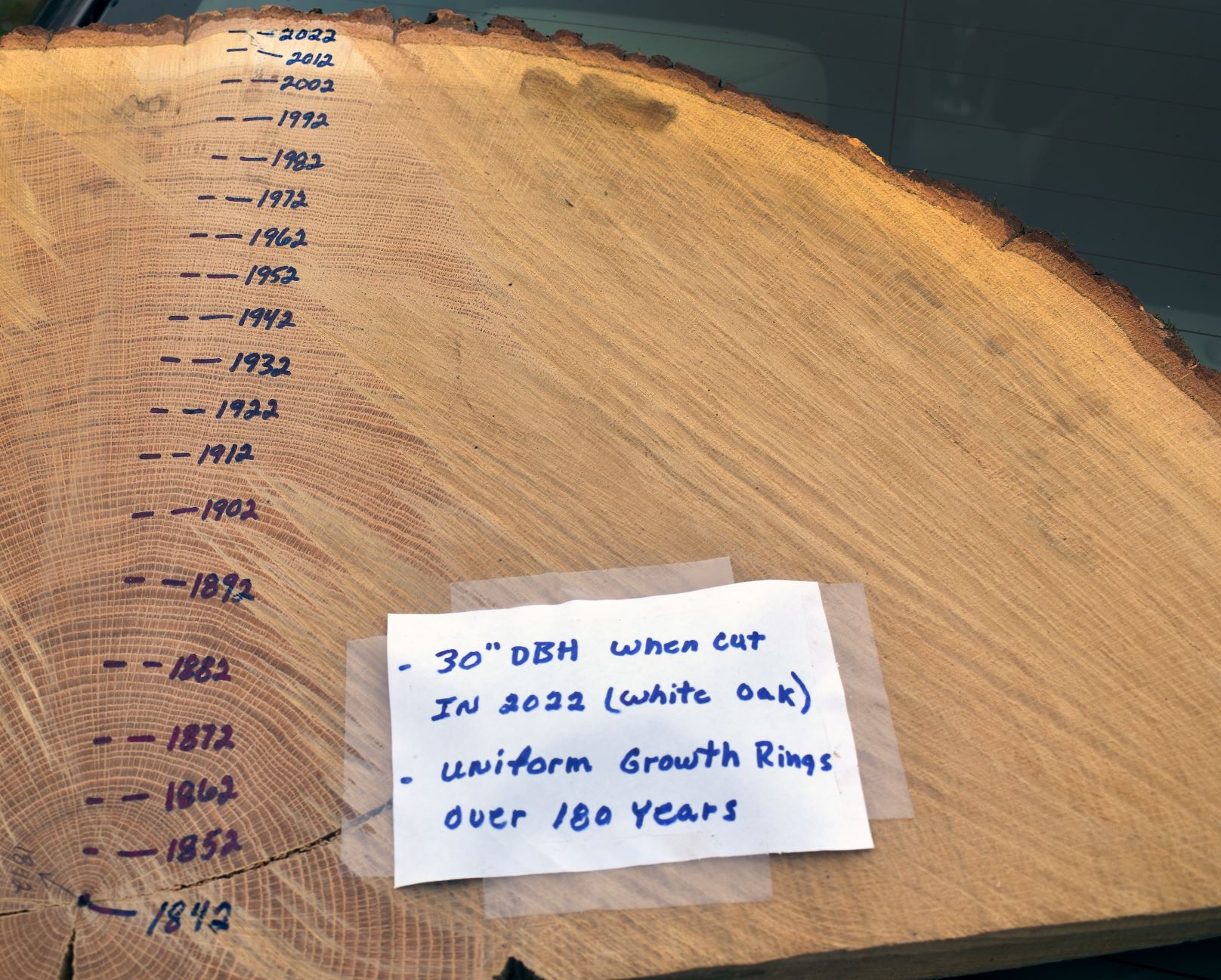
A cross-section of a 180-year-old white oak harvested in 2022 on Jim Schiller’s property near New Glarus.
“It’s nice to be able to come out here with the family and (two) grandkids to show them something other than a game on their phone,” said Schiller — whose own cellphone is still of the flip variety.
The result is an across-the-board success, a thriving woodlot and an example of the good the MFL program can do.
“He sets the standard, and that’s pretty high,” said Matt Singer, a Darlington-based DNR Tax Law Forestry Specialist, with the Division of Forestry’s Tax Law Section.
“When I was first hired in 1991, I went out there and (Schiller) had just bought that first piece (of the property),” Singer said. “I went out there and I saw what he was doing, and I actually learned from him. Things like patch clearcutting and planting were new to me. I kind of cut my teeth learning about forestry in Jim’s woods.”
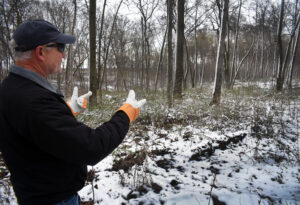
Jim Schiller discusses plans for his property enrolled in the Managed Forest Law program. He has had property in MFL since 1992.
“The more you’re involved with MFL and working with professional foresters, the better it is for you in the long run,” Schiller said. “If you’re in MFL, you have resources to help you make a decent decision. That’s beneficial because there is so much to learn. If you don’t take advantage of it, you’ll lose in the end.”
Schiller can tick off the names of the DNR Division of Forestry staff members he has worked with over the years. “It was very beneficial to have (DNR forester) Rick Livingston there on the first day. He showed me how to prune walnut and told me when and where to clearcut, how to do a proper timber sale and all the things you have to look at before you hold one.”
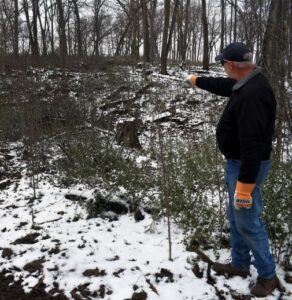
Jim Schiller points out a natural regeneration area for walnut that followed a partial clear-cut in 2018. Schiller estimates that 3,000 trees per acre are regenerating in the small clearing.
Around 2007, Schiller set out to remove the basswood trees from his property — and learned a lesson about how hard he was willing to work to achieve his goal.
“I got two bids, but it never got cut. So, I ended up cutting it myself. I hired somebody with a skidder and we took out 220 basswood trees over one cutting, to open it up for walnut, red oak and hardwoods.
“The market had gone south at that time, so I was forced to cut the timber myself,” Schiller said. “Sometimes you have to take things into your own hands to get them done.”
When he bought the additional acres in 2017, Schiller said “the plan at that time wasn’t really to cut anything.”
But with input from former DNR forester John Nielsen, now a private consulting forester, Schiller decided to hold a sale on a stand of walnut. “It was past due,” he said.
“It’s management and timing. The market and a good seed crop were both in our favor,” Schiller said.
Schiller’s stewardship of his woodlot includes attention to invasive species and unproductive growth.
“I honestly don’t know where he finds the time to do all the work,” Singer said. “But it is his passion and I’m proud to have him as one of my landowners.”
“We did a lot of invasive treatment, taking out cull trees and getting the new growth established,” Schiller said. “Once they hit 10 feet, they take off like a rocket.”
Schiller also eliminated wild geranium from a section that was teeming with it and is about 90 percent finished with a garlic mustard removal project. Next comes the honeysuckle — “they smell nice, but they choke everything out,” Schiller said.
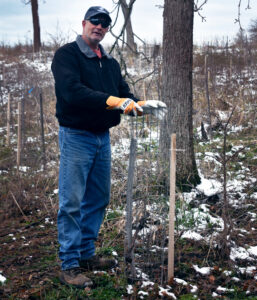
In addition to the removal of some invasive plants, Jim Schiller shows off some newly planted walnut seedlings he is protecting from deer browse.
Nice-smelling or not, Schiller doesn’t want anything to get in the way of the plans he has in place — or the work he has put in, with the help of the DNR’s MFL program.
“It takes 75 years to grow a decent tree,” Schiller said. “You have to be smart about how to manage, what to cut, when to cut, to get the most benefit out of it. … We’re 25 years in here, so at the end of the next 50 years, if everything is still in good shape, then we’ve done OK.
“As we age, I find the need to use more equipment to help with the management practices, and also with outside help. That’s where the MFL comes into play, because that helps to offset the costs for outside contractors and it also provides the landowner with professional guidance to be successful.
“It teaches you that you get out of it what you put into it.”
